Contents
1746 – Portrait of the Courtenay Brothers – Thomas Hudson
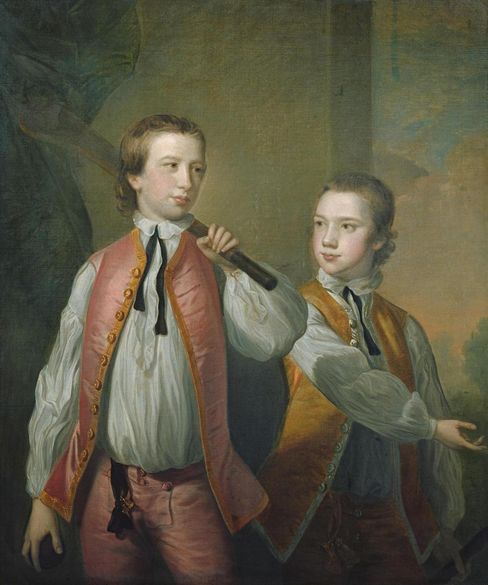
Double, three quarter length, frontal portrait of two young men. The boy holding a cricket bat wears a red waistcoat and breeches. The boy holding a ball wears a gold waistcoat breeches. This ‘conversation piece’ portrait purports to shows two of scions of the Courtenay family of Powderham Castle. The picture is a half-length copy of one section of an enormous painting of the 3rd Duke of Marlborough and family in the Great Hall at Blenheim Palace. William Courtenay 10th Earl of Devon, carries a large oak cricket bat on his shoulder in the customary manner, as an imperious field marshal might be represented with a baton.
Painted by fashionable society portrait painter and art collector Thomas Hudson; it shows William with his younger brother Henry at his elbow directing his gaze diagonally across the composition with his bowling arm. William was not a cricketer of renown but played one first-class match for Charles Lennox’s XI alongside Thomas Lord in 1797.
1760- The Boy with a Bat: Walter Hawkesworth Fawkes – Thomas Hudson
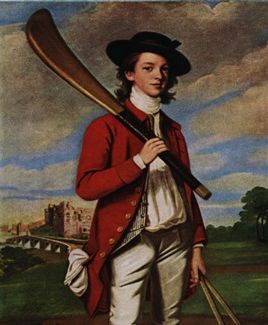
The sitter is not known with any certainty but is suggested to be Walter Beaumont who assumed the name Hawkesworth on marriage and Fawkes on succeeding to Farnley Hall. In the background is Newark castle, a landmark which can be seem from the still-in-use Newark Cricket Ground
1763 – The Cricketers – Benjamin West
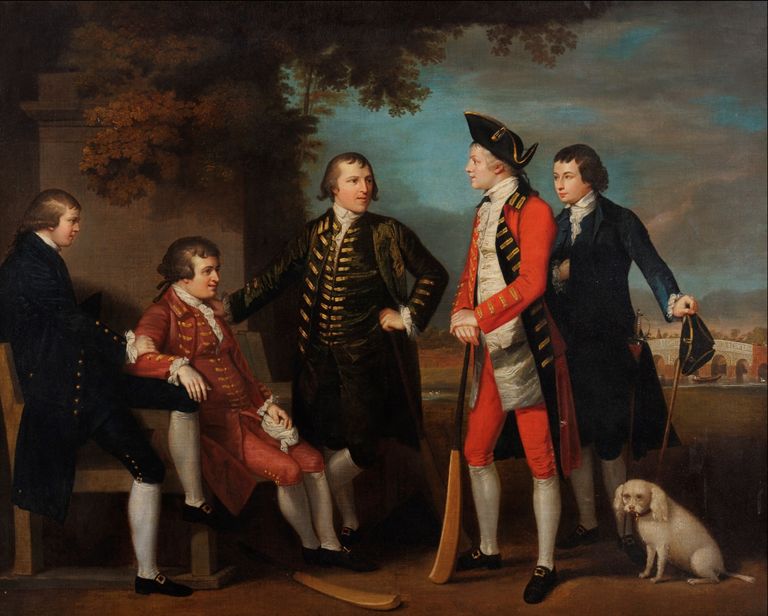
Five finely dressed students in a classical landscape with a bridge visible in the background inspired by British portrait painter and founder member of the Royal Academy, Nathaniel Dance. Dance described similar scenes of English visitors to Italy surrounded by Roman architecture and countryside. Why the cricket bats are there is far from certain.
Artist Benjamin West was born in Pennsylvania and trained in Philadelphia before travelling to Italy, sponsored by William Allen who was reputedly the richest man in the city. He arrived in London in 1763, the year in which it is thought this painting was commissioned. Allen was in London at the time and his two sons are here pictured along with three fellow students. The sitters returned to America to fight in the American War of Independence with Arthur Middleton, one of the signatories of the Declaration of Independence.
West was commissioned by King George III and succeeded Sir Joshua Reynolds as only the second President of the Royal Academy before becoming the Surveyor of the King’s pictures in 1791.
1768 – The Young Cricketer, Portrait of Lewis Cage – Francis Cotes
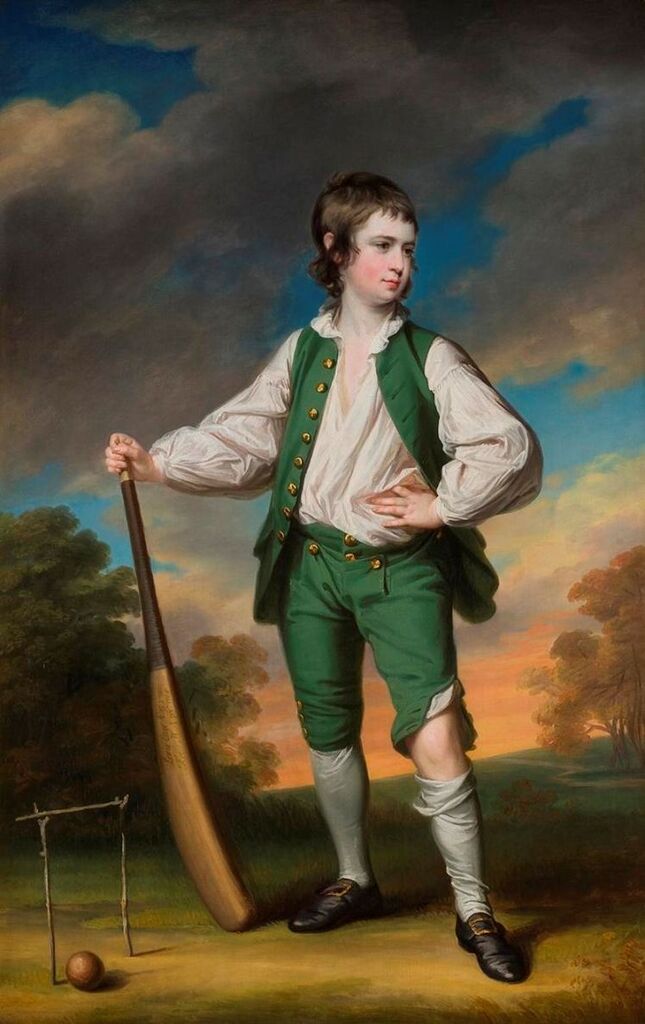
The boy’s lightly grazed knee and unbuttoned finery suggests he is fresh from a game. He stands victorious next to a makeshift wicket holding a bat inscribed ‘Lewis Cage Aged 15’. His confident pose and adult clothing suggest greatness beyond his years – a common theme in portraits of children around this time.
Little is known of the sitter, Lewis Cage, although he is mentioned in correspondence by Jane Austen, and had strong connections with cricket’s heartland of Kent. Three different versions of this picture have been hung at Lord’s during the last century and in 2008 MCC acquired the original.
Painted by British artist and illustrator Francis Cotes, the picture shows the link between life and play, hard work and success. Cotes was Director of the Society of Artists and founding member of the Royal Academy. He lived and worked in Marylebone around the time this picture was painted.
1768 – The Children of George Bond of Ditchleys – Hugh Barron
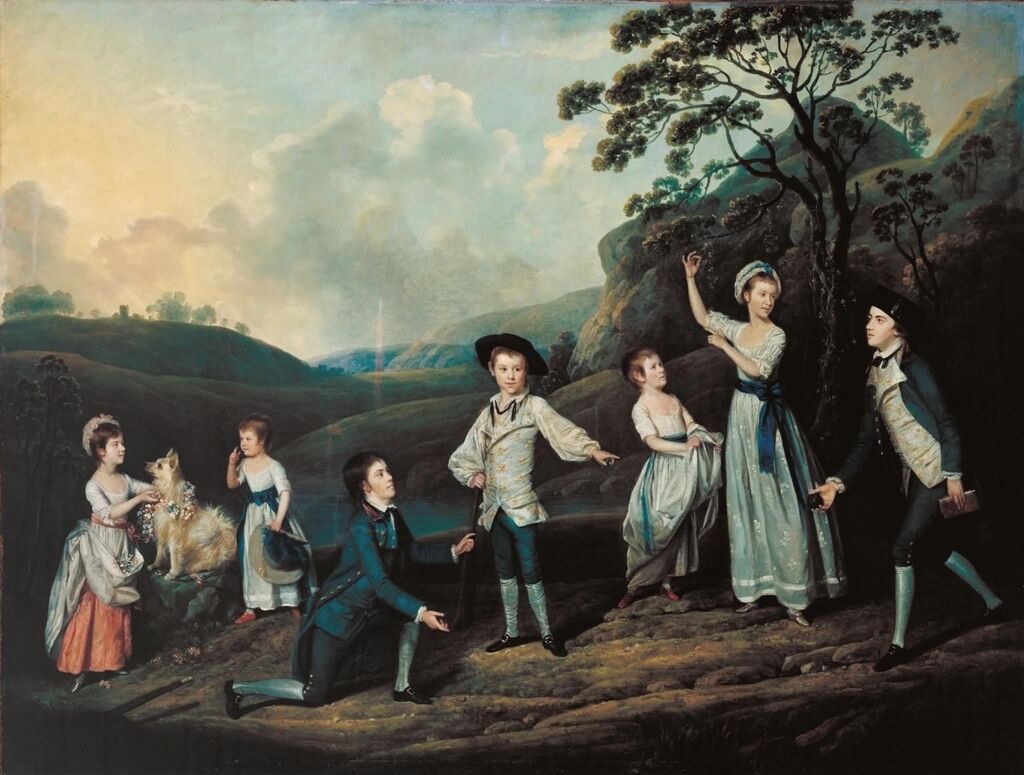
George Bond, father of the seven children depicted in this portrait, was a wealthy city merchant, and an official in the East India Company. The family seems to have occupied several imposing residences, including a country house, ‘Ditchleys’ in Essex, and a Jacobean mansion in Wimbledon.In the foreground, the three older boys play cricket, flanked by their two sisters. Their two younger brothers are dressed in white frocks, as was then the custom for toddlers of either sex.
1770s – Portrait of a Boy – Arthur Devis
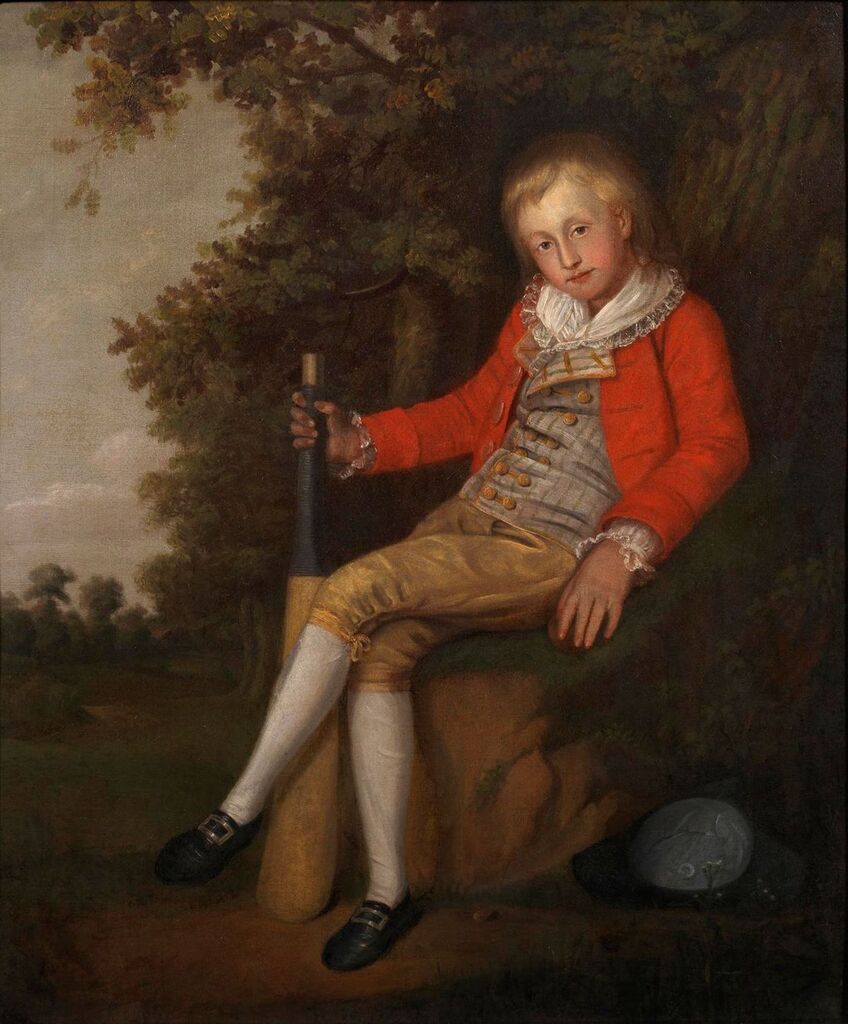
The un-named subject of this portrait is shown holding a shoulderless bat, suggesting the 1770s as the likely period of this painting. Arthur Devis made his name in the mid-18th century as a painter of family portraits, with the subjects often depicted in idealised English landscapes.
The subject of the portrait holds the bat as if it were imposed on him, an implement he doesn’t particularly relate to or engage with.
1771 – A Cricket Scene at Harrow School – Henry Walton
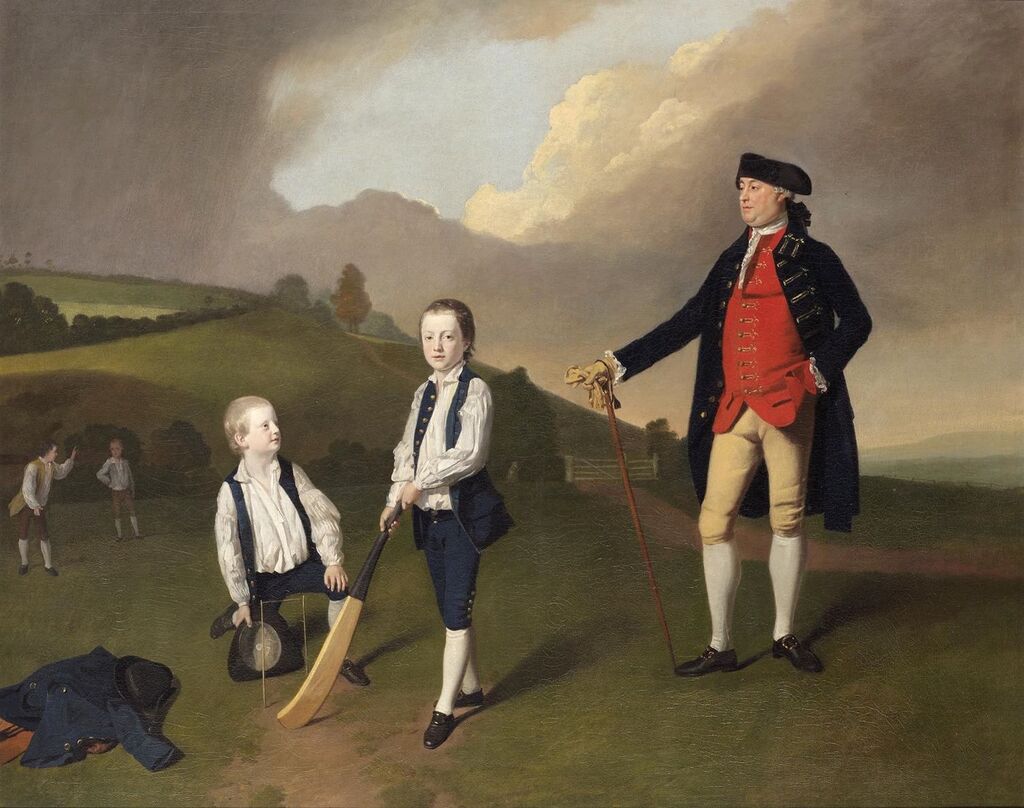
This painting is as much about the game as about the three sitters in the foreground: a professionally made bat of correct proportion, a worn ‘pitch’, a hat to stop the ball, ‘suitable’ dress and distant figures describing the act of bowling. The grip of the batter however, seems to lack commitment, and the keeper is not concentrating in the task in hand.
The three principal sitters are the Mason brothers of Necton Hall, Norfolk with Ambrose Humphrys, a family friend and patron of the painter. John Mason (aged 14) is batting and William Mason (aged 10) is behind the stumps; on the right In the background is Harrow-on-the-Hill.
1771 – Portrait of George Finch, 9th Earl of Winchilsea – Sir Nathaniel Dance-Holland
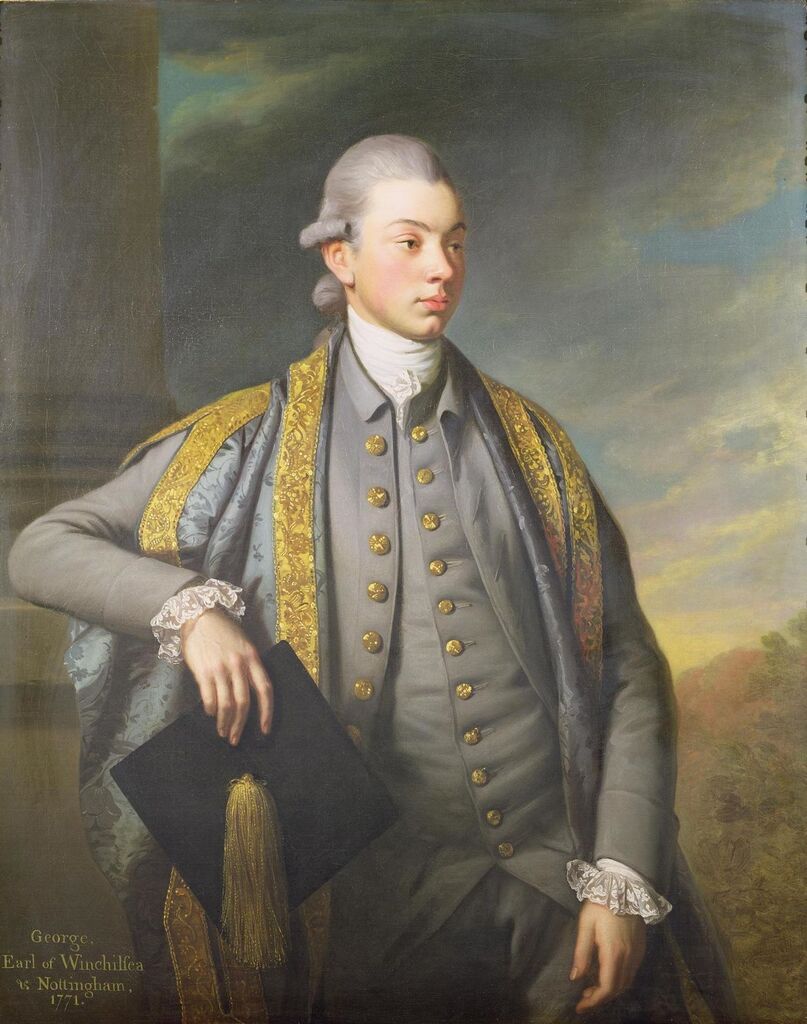
Three quarter length, quarter turned portrait of Winchilsea as a student of Christchurch College Oxford, with powdered hair and wearing his undergraduate robes: a grey gown with gold brocade trim over a grey coat with gold buttons, holding a mortar board.
Leaning against a classical pillar in fine Oxford University undergraduate robes with powdered hair, Winchilsea, shown here at the age of 19, fought in the American War of Independence. As a founder and first President of the Royal Institution, he was responsible for securing the patronage of George III.
As a cricketer, Winchilsea was a leading figure in the White Conduit Club (WCC). He and his club colleague, Colonel Charles Lennox, are credited with backing Thomas Lord in the search for a new ground where MCC might play; Lord found his ground in Dorset Fields, Marylebone and MCC was born.
Artist Nathaniel Dance-Holland spent over ten years training in Italy under painter Pompeo Batoni, known for his faithfully reproduced trappings of classical Rome. Dance-Holland returned to establish a successful portrait practice in London and became a founding member of the Royal Academy.
1778 – Miss Wicket and Miss Trigger – John Collet
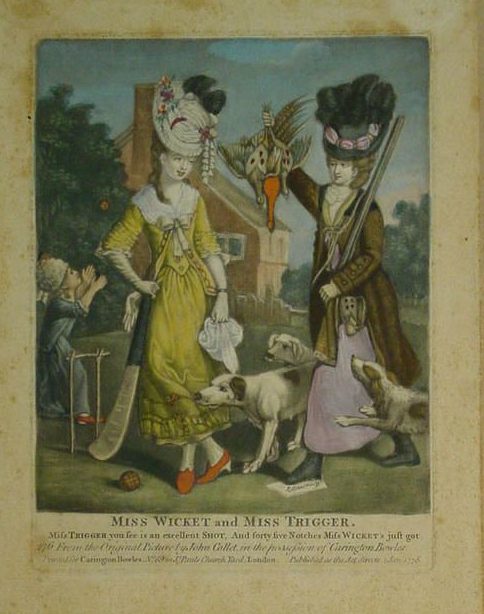
A print from 1778. The caption says “Miss Wicket and Miss Trigger. Miss Trigger you see is an excellent shot, And forty five notches Miss Wicket’s just got.” Miss Trigger is standing of a piece of paper on which the word effeminacy is clearly written. Is this being critical or expressing support? Certainly the ladies seem in fine spirits.
Miss Wicket meanwhile has been suggested to be the Countess of Derby. Note the two stump wicket, although the third stump started to be used in 1776.
1780 – Portrait of a Youth with Cricket Bat, 1780 – William Alexander
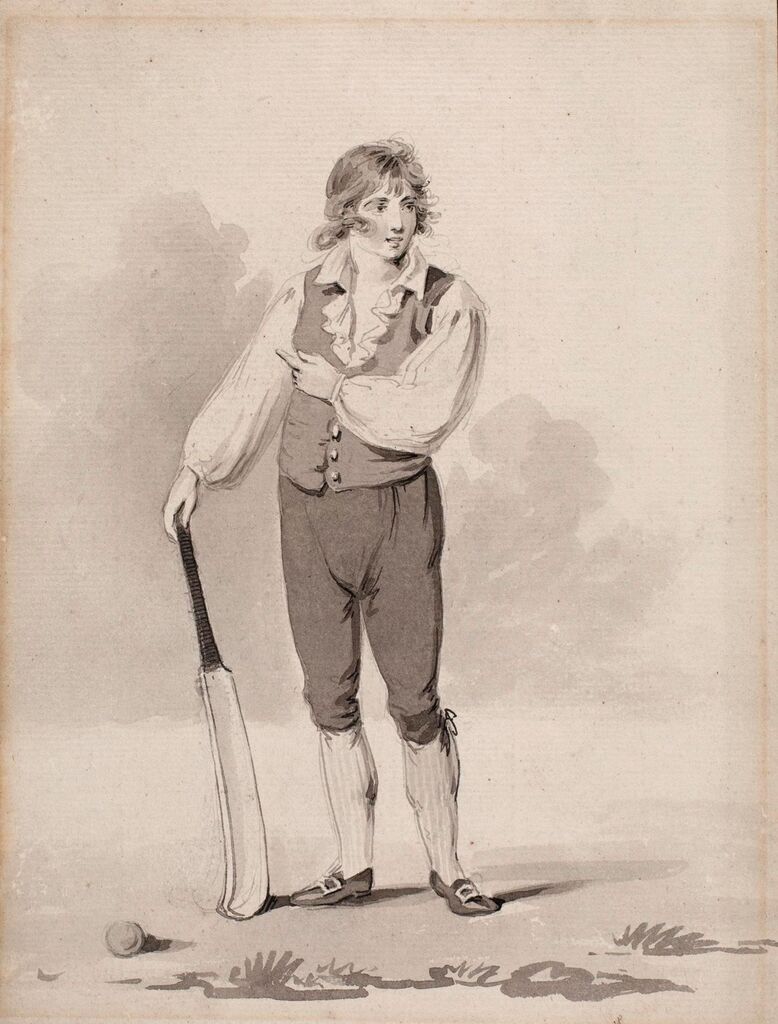
Monotone, full length, frontal, portrait of a young man. He looks to the right and points left. He is wearing a frilled shirt with full sleeves, waistcoat and dark britches, stockings and shoes with buckles. He holds a bat with a slightly curved blade and twine wrapped handle in his right hand. There is a ball on the ground and some vague clouds in the background.
1780 – Portrait of a Batsman – William Hamilton
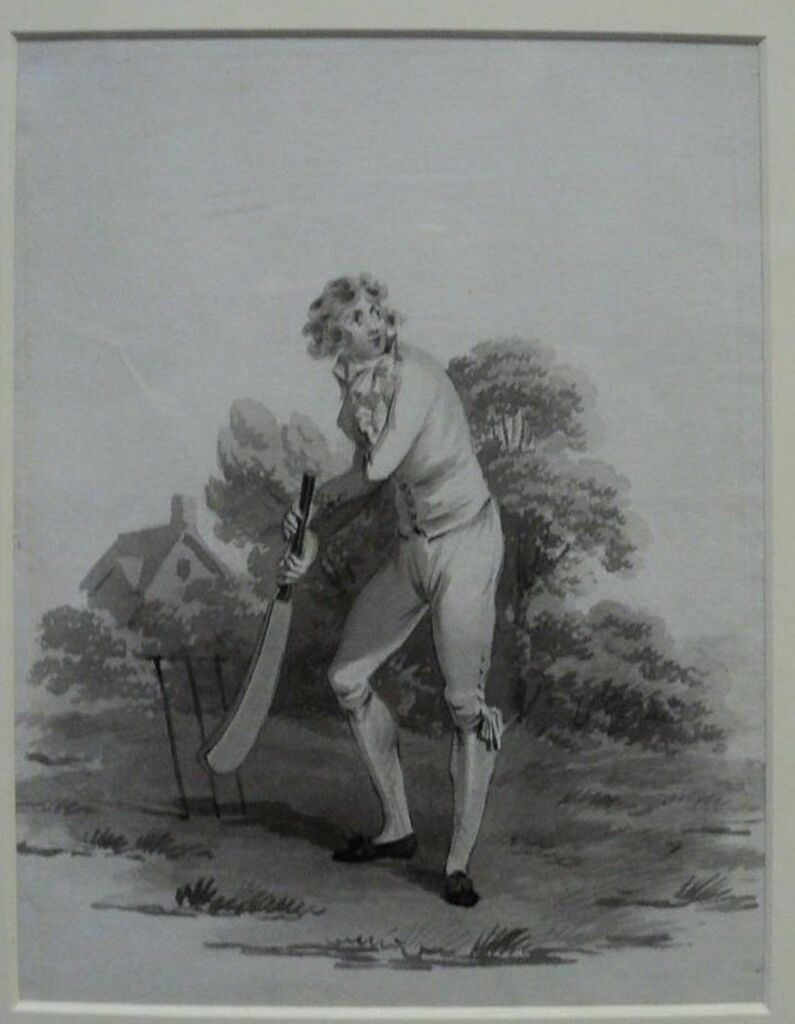
Framed, mounted and glazed grey tone sepia drawing of a young cricketer, with short curly hair, holding a curved bat. Wearing a buttoned jacket and knee breeches, standing before a three stump wicket. Trees and cottage in background.
It is hard to see how this character can hope to make a single notch – his grip is perverse in the extreme. What we might call now, ‘a walking wicket’.
1783 – Edward ‘Lumpy’ Stevens – Almond
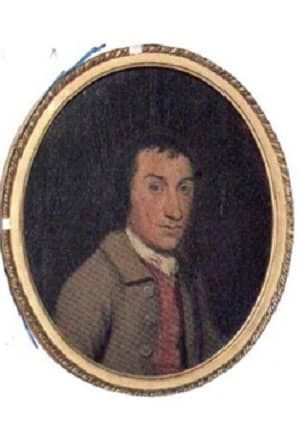
Lumpy is painted, not in the character of a cricketer, but as a servant of of the 3rd Earl of Dorset. In fact, his service consisted solely of playing cricket and this is the first portrait of a cricketer, produced purely by reason of his prowess at the game. The back of the painting has the inscription – Stevens, alias Lumpy, the famous player at cricket.
1785 – The Cathcart Family – Cricket in Scotland – David Allan
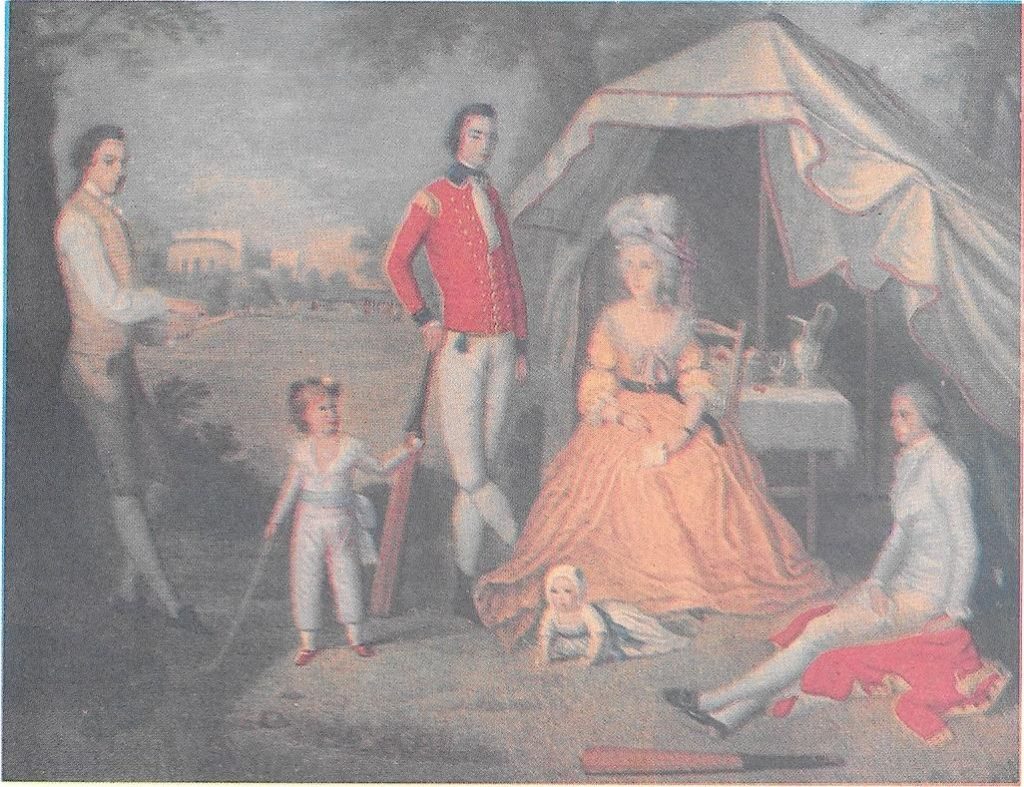
The first illustration of cricket in Scotland, the figures in the distance behind the small boy (Willaim, Master of Cathcart) are actually playing cricket, this was an illustration of a real scene. Lord Cathcart (centre) was then commanding officer of the Coldstream Guards and had borrowed the tent from his regiment.
This scene has been reproduced in other forms, including engraved glass.
It looks to me as if his Lordship has a modern style bat while William has one of the very old hockey-stick type bats – perhaps for playing a different game.
1786 – Portrait of William Wheatley, at the age of fourteen – Francis Alleyne
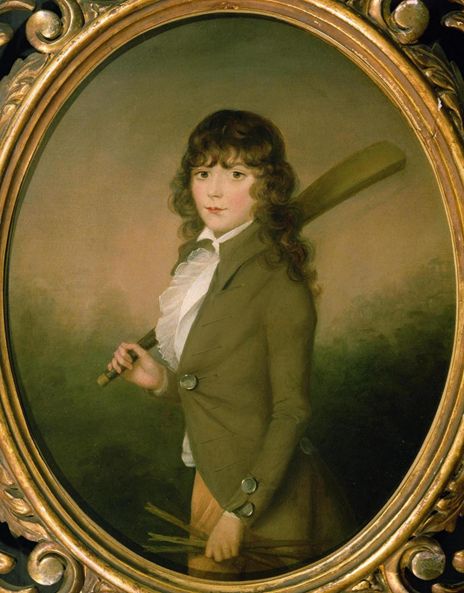
Three quarter length, three quarter turned portrait of a boy with shoulder length brown hair wearing a brown frock coat holding a bat over his right shoulder and three stumps in his left hand. As cricket became more respectable during the latter part of the 18th century, it became fashionable for the children of noble families to be depicted in cricket-themed portraits. Here William is depicted wearing a brown frock coat in the classical cricket portrait style, denoting high status, with a bat over shoulder and three stumps in his left hand. The Wheatley family lived at Erith in Kent. William attended Charterhouse School and later joined the 1st Foot Guards, rising to the rank of Major-General before dying of a fever at Madrid while serving under Wellington in the Peninsular Wars.
Francis Alleyne was an itinerant portrait painter who travelled around England visiting country houses and painting family portraits between 1774 and 1790. Many examples of his work can still be seen in family collections; this small, oval three-quarter length portrait is typical of his style.
1790 – Twelve Cricketers in Characteristic Attitudes – George Shepherd
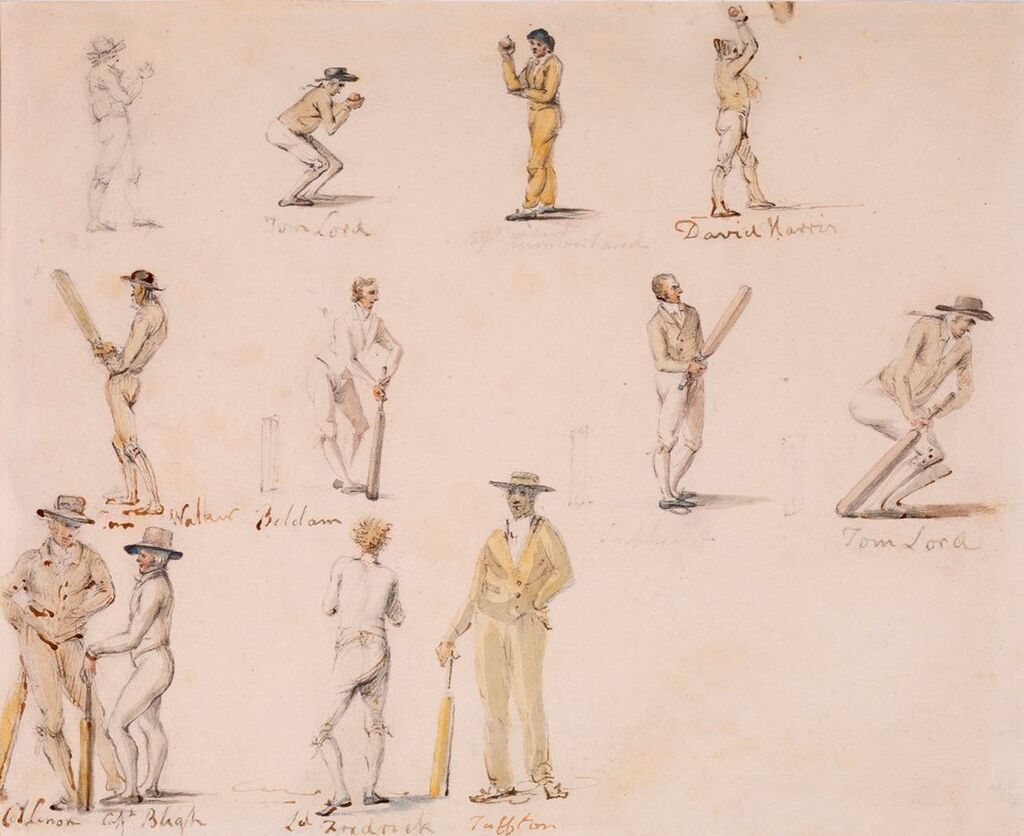
Twelve full length studies of cricketers, including three members of the Hambledon team, in bowling and batting positions. Top left pencil sketch of man with hands held out in front of him. To the right of him Tom Lord, knees bent, ball in hand as if to bowl underarm. Then Captain Cumberland with his right arm raised with ball in hand, wearing hideous mustard suit. Right of him is David Harris with his right arm raised above his head holding a ball. Middle left is Tom Walker holding a bat pointing upwards. Beldham to his right holding a bat in forward defense in front of a wicket. Then a man with illegible name beneath holding a bat upwards in front of stumps. To his right Tom Lord in front of the stumps with bat. Col. Lenon/Lennox (4th Duke of Richmond) and Capt. Bligh are talking on the bottom left. Both holding bats. To the right Lord Frederick and Tuffton are talking.
In summary – Top row – Unknown; Thomas Lord; Capt Cumberland; David Harris. Middle row – Tom Walker; William Beldam; Unknown; Tom Walker. Bottom Row – Col Lennox; Capt Bligh; Lord Frederick Beauclerk, Tufton.
1790 – Youth with Cricket Bat
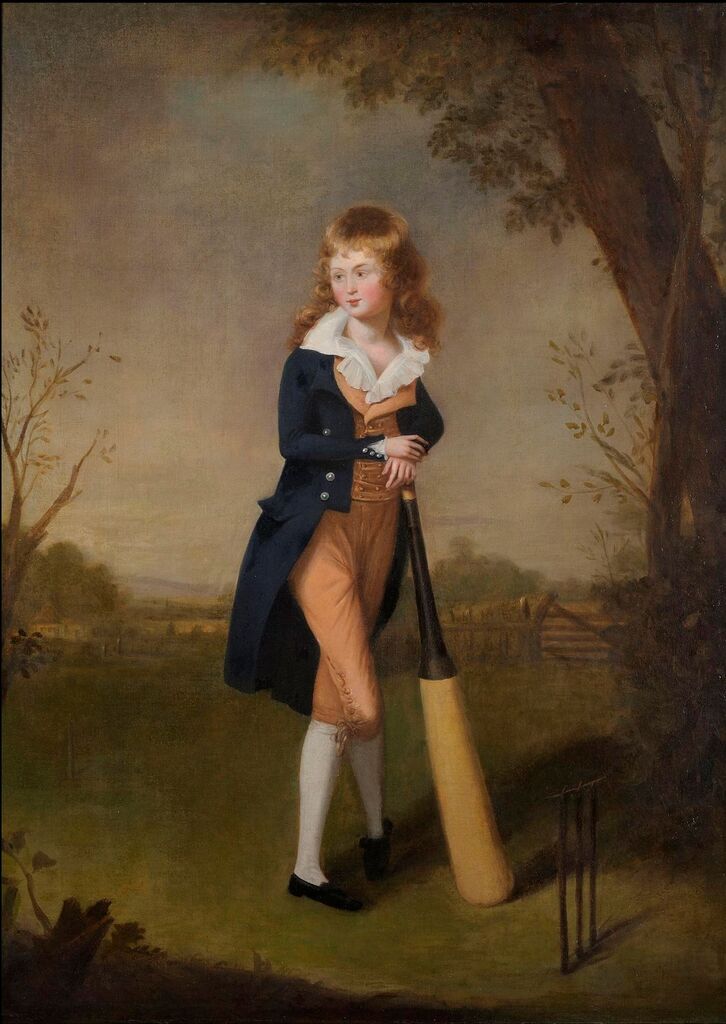
Full length, frontal portrait of a young boy standing in the lee of an oak tree leaning on a cricket bat, looking left. Wearing dark blue coat, yellow breeches and waistcoat. This picture has all the traditional compositional elements of an 18th century British portrait – a sitter in formal dress standing in the lee of an oak tree, the traditional symbol of England, surrounded by countryside in a crosslegged stance that was a conventional pose of gentility.
The painting was, in the early catalogues of MCC, attributed to Thomas Gainsborough and at one time the boy was thought to be of Royal blood. However nothing concrete is known of either the artist or the sitter, though the latter appears an angelic English boy of high status. The stangley crossed legs do not suggest a natural engagement with the game, but perhaps there is some steel in the eyes.
1795 – Thomas Hope of Amsterdam – Jacques Sablet
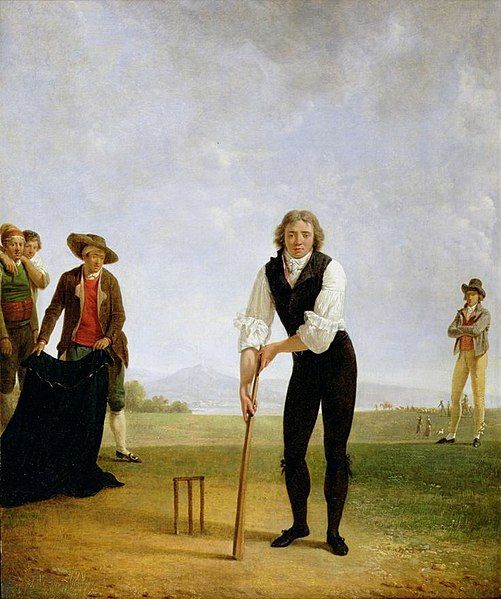
Portrait of a young gentleman in black waistcoat and breeches in front of a three stump wicket, holding a pole-like cricket bat. The figure at the wicket holds a black cloak, perhaps anticipating the likely uninterrupted passage of the ball. A volcano, possibly Mount Vesuvius near Naples, Italy, in background.
Thomas Hope was the son of an English father long established in Amsterdam as a banker, and a Dutch mother, and he is shown playing cricket in the Roman Campagna. Hope devoted much of his youth to an extended grand tour, which lasted almost ten years, and was aged 22 when the Swiss-born Sablet was commissioned to paint him. In 1796, when Holland was occupied by the French, Hope left for England where he became one of the most successful designers of furniture and interiors of the Regency period.
I have to say, I do not recommend his technique. He looks vulnerable to the yorker. And everything else. Another walking wicket.
1805 – John Nyren
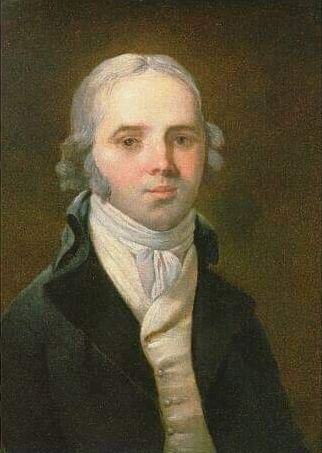
Portrait of the most important of all cricket writers, John, Son of Richard Nyren, himself captain of Hambledon and landlord of the hut, later known as The Bat and Ball.
